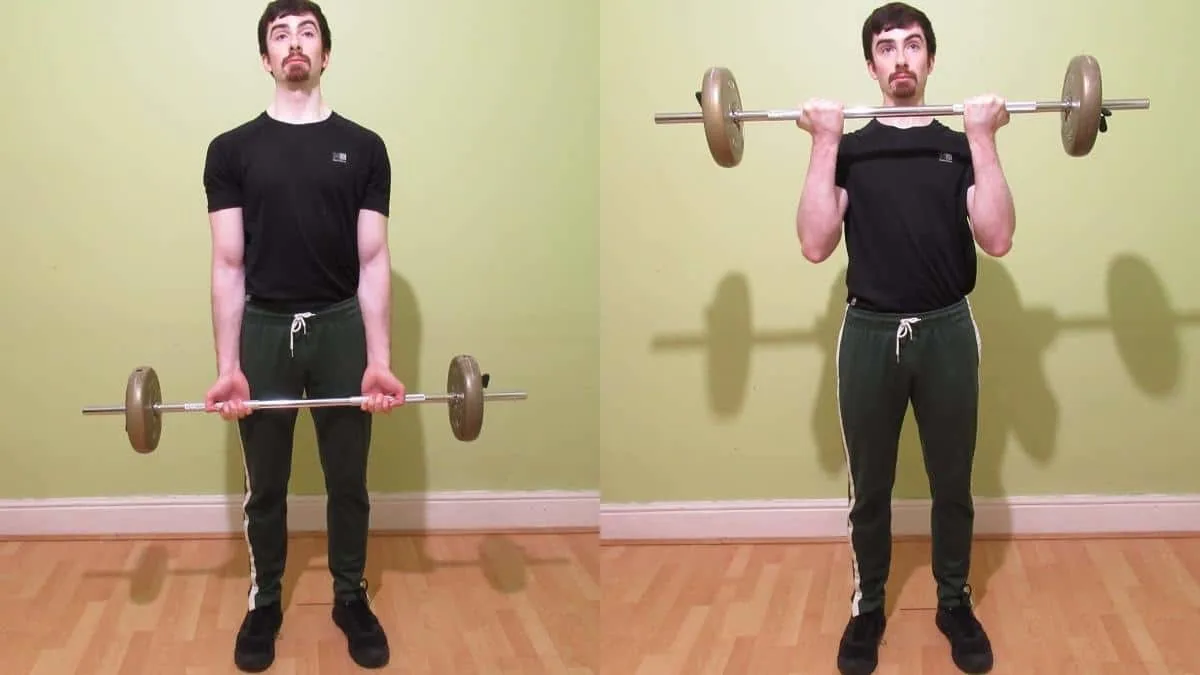The standing barbell curl is arguably the top bicep exercise for building the bicep muscles.
This is because it enables you to lift far heavier than other movements, and so you can make your biceps grow faster by overloading them with more resistance. The movement makes a great addition to any back and biceps day, but you can also perform a separate arm session if you want to train with more specificity.
This guide shows you how to barbell curl with the proper form and then breaks down the crucial tips that will help you to get the most from your BB curls.
Related: Barbell curl vs dumbbell curl│Barbell curl standards
Standing barbell curl exercise details
- Also Known As: Straight bar curls, BB bicep curls
- Main Muscles: Biceps brachii
- Secondary Muscles: Brachialis, brachioradialis, forearm flexors
- Exercise Type: Strength
- Exercise Mechanics: Isolation
- Difficulty Level: Beginner
- Equipment Needed: Barbell, weights
How to do barbell curls with the proper form
- Load an appropriate amount of weight onto a barbell that you can lift for 6-12 reps.
- Grab the barbell tightly with a shoulder-width underhand grip.
- Stand up straight with the bar resting on your thighs. Your chest should be up and your shoulders pinned back slightly.
- Curl the bar toward your shoulders by flexing your biceps.
- Keep lifting until the undersides of your forearms forcefully press up against your biceps.
- Hold the contraction for a second and then lower the weight under control until your elbows reach full extension.
- Perform 3-5 sets of 6-12 reps in total.
Standing barbell curl tips
Straight barbell curls are a relatively straightforward exercise because you only need to perform one task—elbow flexion. But despite the simplicity, many lifters still limit their progress by making various technique mistakes. Therefore, we added this guide to show you how to use the proper barbell curl form and tweak your training so that you can get the best results.
Always perform a full range of motion
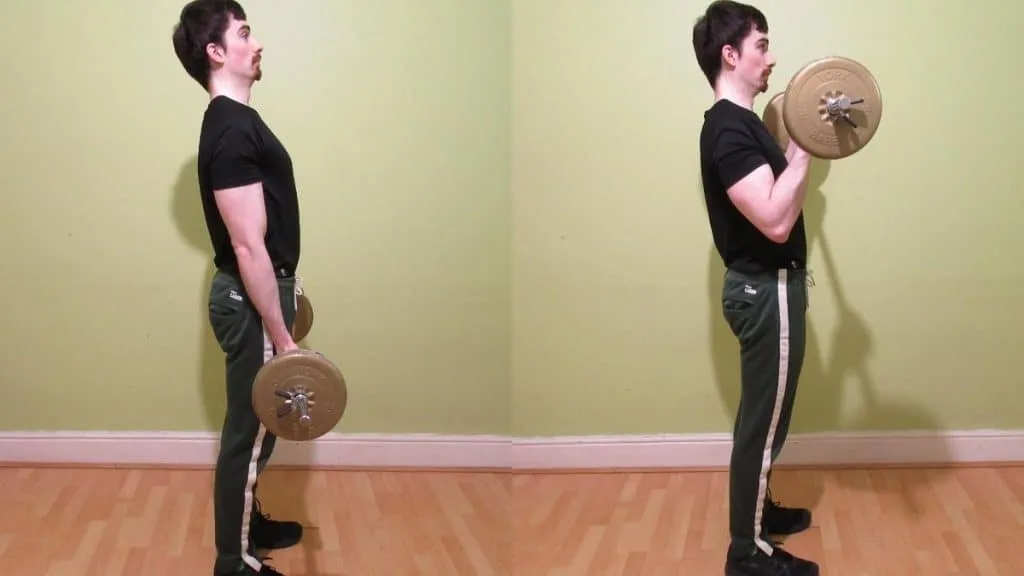
You should always perform complete repetitions to get the most from the barbell biceps curl. This involves lifting the bar all the way up—until the undersides of your forearm press right up against your biceps—and then lowering the weight, not necessarily slowly, but under control until your elbows reach full extension.
The advantage of doing full range of motion (ROM) standing barbell curls is that you’ll recruit more muscle fibers because you’ll be applying tension to a larger portion of the biceps. [1] With partial reps, on the other hand, you’re often leaving parts of your biceps completely understimulated by arbitrarily shortcutting the lifting motion.
While you’ll need to lift lighter weight than if you were half repping, the enhanced motor unit recruitment that you’ll get from full ROM Olympic bar curls will lead to more bicep hypertrophy in the long run.
Conversely, if you don’t kick the half rep habit, you’ll impair your mind-muscle connection while simultaneously jacking up your injury risk. This is because when you use momentum to get the bar moving, you’re initiating the rep with a muscle group other than your biceps. Hence, you also reduce your ability to feel the target muscle working, which defeats the purpose of this isolation exercise.
In other words, there’s no point in trying to set a new world record barbell curl when you’re training for hypertrophy.
Use a proper bar path
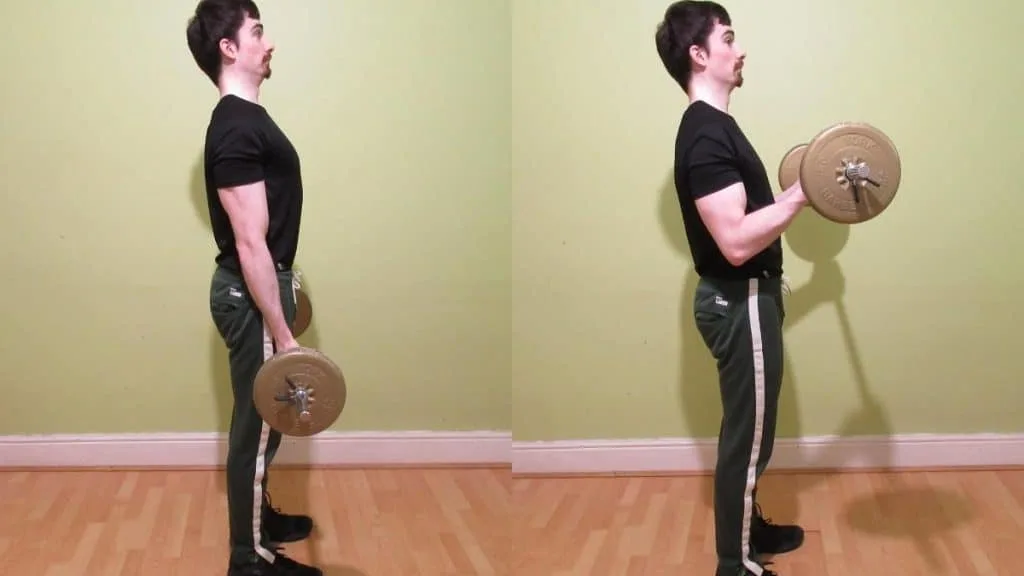
Many lifters keep the barbell too close to their body during the straight bar bicep curl.
Although lifting this way can indeed generate a potent muscle pump, it doesn’t put your biceps under an optimal stretch to stimulate maximum muscle growth.
Instead, you should stay true to the standing straight bar curl by arcing the barbell forward.
The biceps, after all, is a shoulder flexor. So you can actually allow your front delts and elbows to move forward slightly, especially as you complete the concentric phase of the rep.
Of course, you shouldn’t swing the weight up with your shoulders. Rather, you’re simply raising them slightly to intensify the peak contraction.
On the other hand, if you’re a former ego lifter and don’t trust yourself to use the correct barbell curl technique when implementing the above tip, you can just keep your shoulders and elbows as still as possible to minimize cheating.
Find your optimal grip width
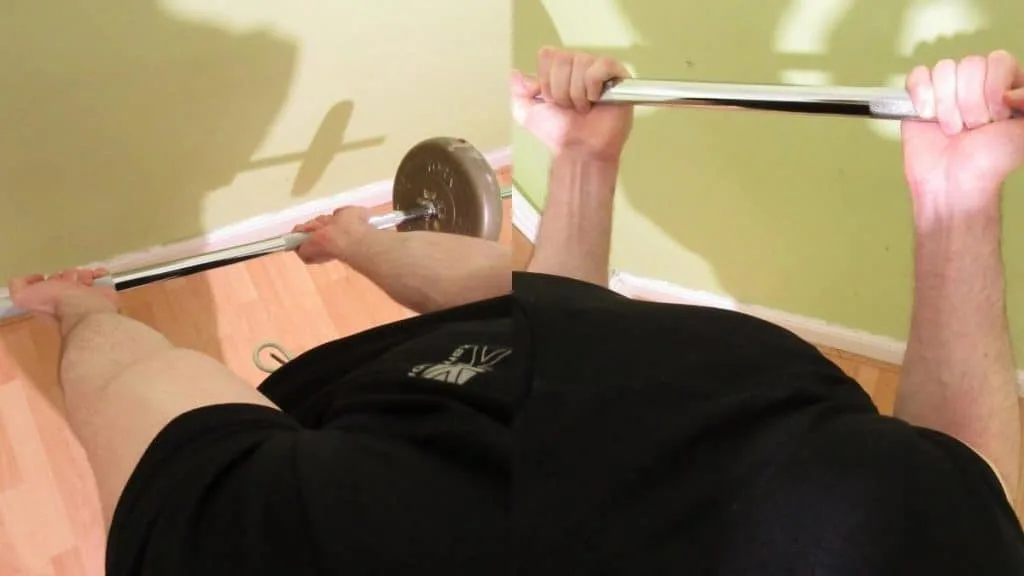
The optimal grip width for barbell curls depends, first and foremost, on your anthropometry but also on your goals.
Let’s start with the latter factor.
Using a wider grip on the straight bar arm curl will help to emphasize the inner head of your biceps, whereas curling with a closer grip will target more of the outer muscle fibers.
But finding a comfortable grip width that allows you to curl pain-free is by far the most important objective.
For example, if you have really wide shoulders, then a wider grip will feel much more natural for you than for someone with narrower shoulders.
So, like many strength training variables, the ideal barbell curl grip width is relative and something that you should experiment with.
Don’t overdo the training volume
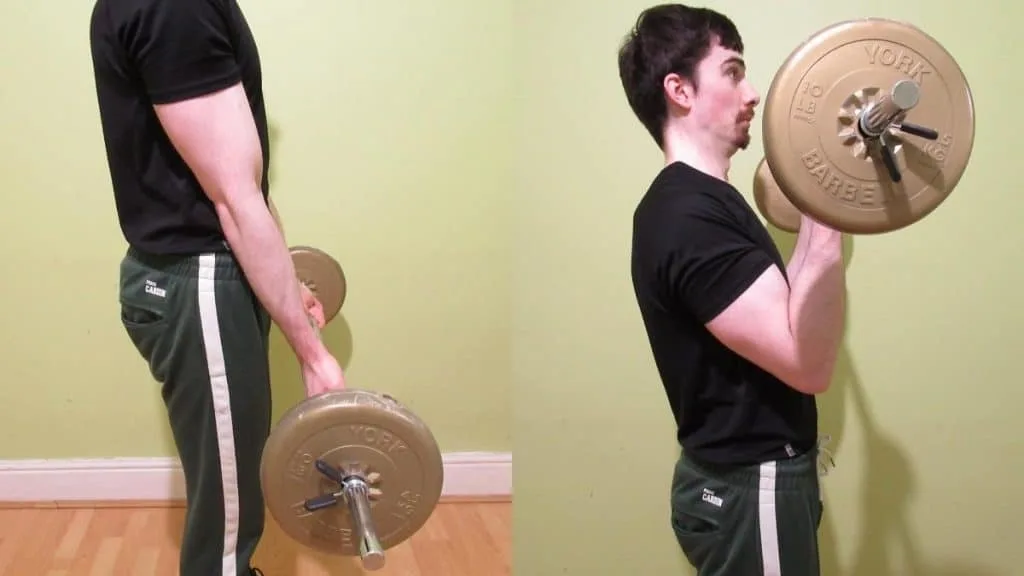
Training volume is a complicated topic. And in more recent times, it’s become a highly controversial one as well.
What I’m getting at is that you don’t want to do too many barbell bicep curl sets, especially not in one workout.
Performing excessive training volume—which varies highly according to individual recovery capacities, training experience, and diet quality—can damage or even completely sabotage your results if you don’t temper it with periods of lower volume training.
If you do too much BB bicep curl volume, then you’ll likely feel physically under-recovered and mentally unmotivated. This, in turn, will lead to strength regression, it’ll impair your ability to get a pump, and you’ll also find it harder or impossible to gain new muscle.
Instead, you’re much better off performing 3-5 quality standing barbell curl sets per session in conjunction with one other arm exercise. You can always scale up the training volume and progress beyond a basic bicep workout as the mesocycle progresses (or as you generally get closer to your genetic potential).
Likewise, you can split up your current standing bar curl sets over multiple days of the week to sneak in extra volume while increasing your recovery. Or, to say it another way, you’ll be stronger and thus able to accumulate more volume by doing 5 sets twice per week than you will be by doing 10 sets upfront in a single session. [2]
Barbell bicep curl variations

Besides the standing BB curl, there are more than 8 mass-building variations of the straight barbell curl that you can perform to beef up your biceps. See the links below for a complete tutorial on the other types of bicep curls, or keep scrolling for a full FAQ.
You can also check out our detailed barbell biceps workout guide if you’re looking for a good routine to follow.
Or, for entirely different exercise options, see our post regarding the most suitable barbell curl alternative for muscle growth.
- Barbell hammer curl
- Barbell preacher curl
- Barbell spider curl
- Barbell drag curls
- Reverse barbell curl
- Barbell concentration curls
- Barbell cheat curl
- Seated barbell curl
- Close grip barbell curl
- Wide grip barbell curls
- Barbell curl and press
- Single arm barbell curl
- Chain barbell curl
- Cable curl vs barbell curl
Barbell curl FAQ
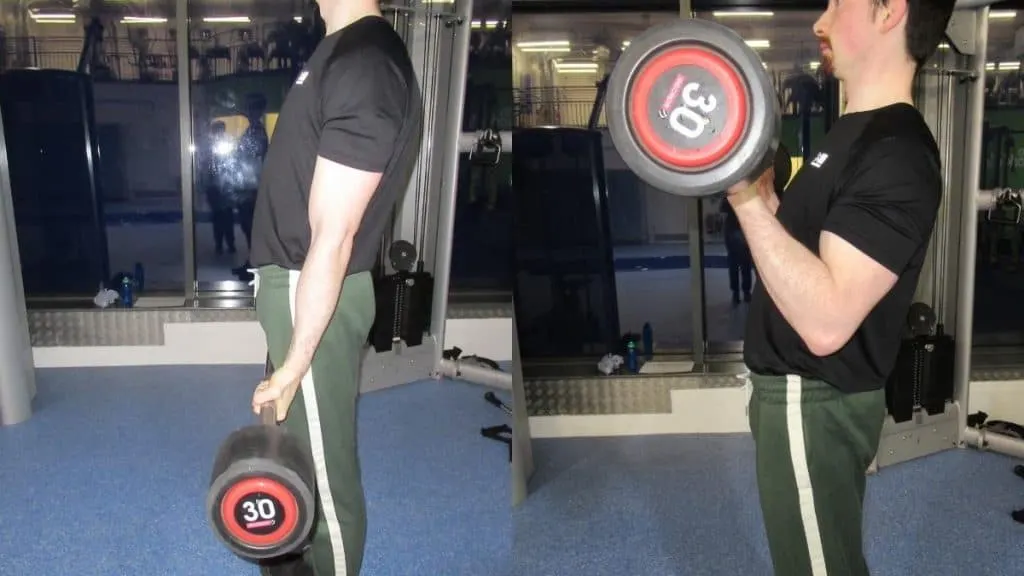
What is a barbell curl?
A standing barbell curl is a bicep exercise that weight lifters and bodybuilders perform to increase the size and strength of their upper arms. It’s a popular exercise because it enables the lifter to curl heavy weights and overload their biceps with a high amount of resistance.
What muscles do barbell curls work?
The barbell curl exercise primarily works the biceps brachii. It also trains the brachioradialis, brachialis, and forearm flexor muscles to a significant degree.
What are the benefits of barbell curls?
The main benefits of performing a standing barbell bicep curl are increased muscle growth (hypertrophy) and strength development. The BB curl exercise can also improve your muscular endurance and bone density by getting your bicep muscles and surrounding tissue structures used to handling resistance on a regular basis. [3]
Should you do heavy barbell curls for mass gain?
As long as you perform a proper barbell curl using good technique, then it’s fine to lift heavy weights. Doing so will help the fast-twitch muscle fibers to grow larger while also increasing your strength. Just note, however, that heavy is relative and is usually denoted by the number of repetitions that you perform (low reps = heavy weight) rather than the amount of resistance on the bar.
What’s a good barbell curl workout?
The optimal bicep barbell curl workout depends on your goals and training experience, among many other factors. However, as a general guideline, perform 3-5 sets of standing bar curls 1-3 times a week and do 6-15 reps on each set. Do less if you’re a beginner and more if you’re an advanced lifter.
Are barbell curls good for women?
Yes, stand up straight bar curls are good for any woman who wants to improve the size, strength, or endurance of her biceps. Being male or female, in general, doesn’t have much bearing on the effectiveness of exercises; rather, the suitability of a movement depends on your training and physique goals, which differ wildly between individuals.
Read More: Barbell curl vs EZ bar curl │Best bicep superset
Conclusion: How effective are standing straight bar curls?
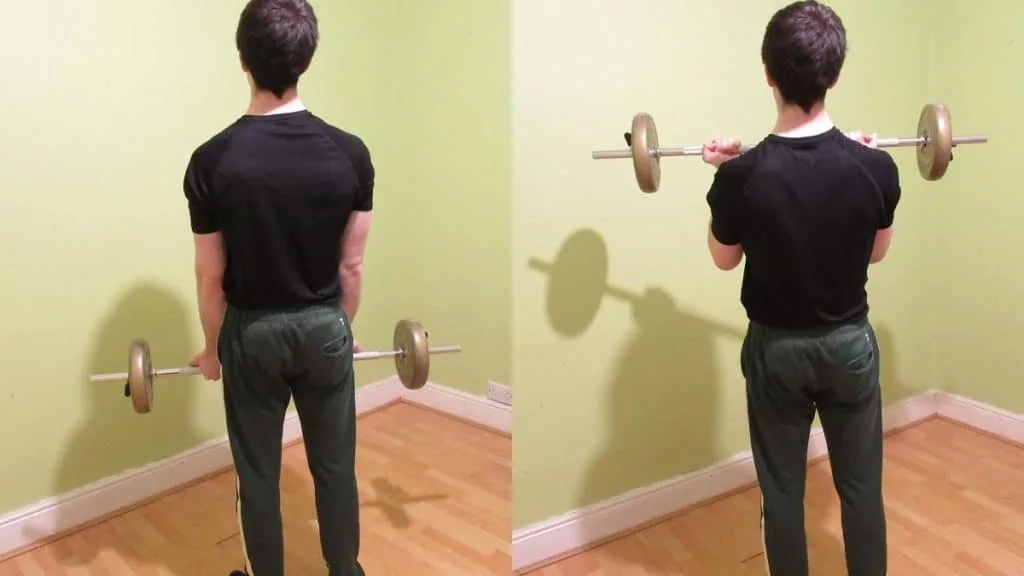
The standing barbell curl has been developing the biceps of weight lifting enthusiasts and bodybuilders for decades, and it’s not going to stop building slabs of mass anytime soon.
Straight barbell curls enable you to overload your muscles with more resistance than any other inner bicep exercise drills. Hence, they’re one of the most effective movements for size gain when you use the proper form.
In closing, always perform the barbell bicep curl with strict, hypertrophy-focused technique if you want to get the best results from your efforts. Of course, you should also seek to add weight to the bar as your biceps gain true strength from your full range of motion reps. Still, curling with the proper form should always be your first priority.
References
- Schoenfeld, B. (2018, July 6). Ask The Muscle Doc: What’s The Best Range Of Motion For Maximizing Muscle? Bodybuilding.Com. https://www.bodybuilding.com/content/ask-the-muscle-doc-whats-the-best-range-of-motion-for-maximizing-muscle.html
- MacCormick, T. (2020, August 13). Use High Frequency Bodybuilding to Avoid Junk Volume. Breaking Muscle. https://breakingmuscle.com/fitness/use-high-frequency-bodybuilding-to-avoid-junk-volume
- Harvard Health. (2020, October 16). Strength training builds more than muscles. https://www.health.harvard.edu/staying-healthy/strength-training-builds-more-than-muscles

